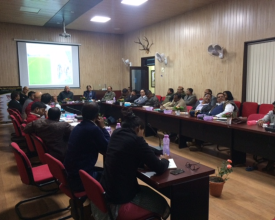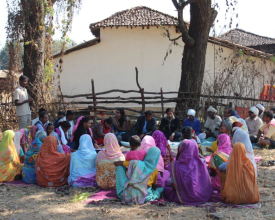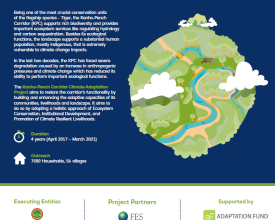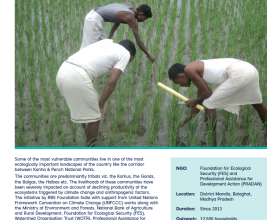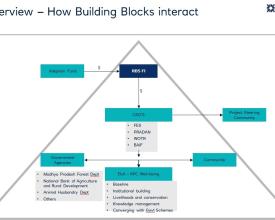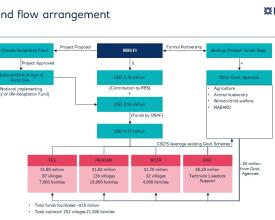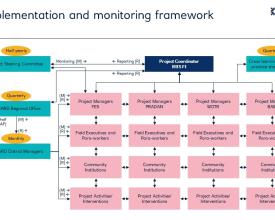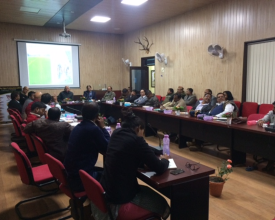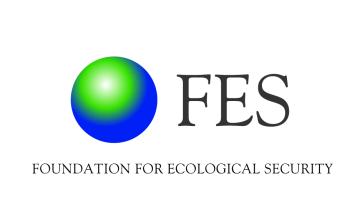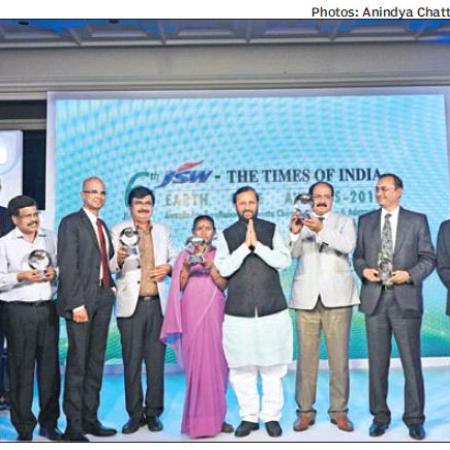
Creating sustainable partnerships and financing for the Kanha Pench Corridor (KPC)
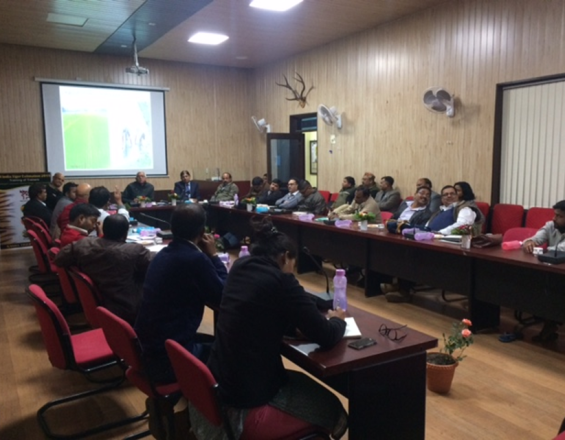
Kanha Pench Corridor (KPC) is a vital ecosystem spread on 9,000 sq km, linking two Protected Areas (PA) - Tiger Reserves of Kanha (60-80 Tigers) and Pench (40-50 Tigers). The KPC is a mix of PA, non-PAs, revenue and private lands and provides livelihood to over half a million indigenous people who reside within it. It also provides services like regulating hydrology and sequestering carbon. Over recent decades, the KPC has faced severe fragmentation/degradation due to anthropogenic activities and climate change. In 2010 RBS Foundation India (RBS FI) began working in the KPC and over time realized that collaboration and pooling resources was pivotal to ensure the long term well-being of KPC and its dependent communities. RBS FI took a leading role in bringing the key stakeholders (government+ civil societies) together on the same platform and ensured sufficient resources (USD 10 mill, inc. USD 2.56 mill from Adaptation Fund) for KPC.
Context
Challenges addressed
- Creating a long term & conducive partnership with Forest dept is critical yet difficult due to frequent officer changes and related variations in orientation, priorities etc
- Collaborating with ideologically strong civil society partners and guiding them to work together to adopt a consistent approach for achieving the objectives. To ensure there is flexibility in a rigid system.
- Managing inter and intra community conflicts since the project is being implemented at a landscape level.
- To design interventions that create a balance between the environment and socio-economic aspects. No socio-economic interventions (e.g. agriculture, livestock development) promoted should harm the ecological integrity of the KPC, and vice versa.
- To facilitate pooling of resources from diferent sources and prevent overlap. Ensure implementation, reporting and monitoring requirements of the donors including environmental and social safeguards.
Location
Process
Summary of the process
Working together requires all stakeholders to collaborate through a platform for a common goal. Working Together requires the group of organisations part of this solution to understand and meet each other requirements. To work in large landscapes and address community/ conservation issues requires a long term commitment and intensity; - this requires financing. Thus, sustainable financing is critical to ensure stakeholders work together, .
In this solution, RBS FI has brought multiple CSOs, government agencies and other stakeholders on one platform to interact and implement activities on conservation and livelihoods adopting the approach of EbA. RBS FI has taken a lead role to establish a Project Steering Committee and through its own funds and from AF's support it has ensured sustainable and varied sources of funding. By partnering with the State Forest Department and Animal Husbandary Department and NABARD, RBS FI has ensured financing is received from government programmes to this solution.
Community contributions are another critical source of financing which ensures sustainability of initiatives at the village level and provides a corpus which is used as a coping mechanism by the community.
Building Blocks
Working Together to optimize efforts and resources in KPC
Ecosystem-based adaptation and conservation of non-PAs is possible only in done at a landscape level. Multiiple stakeholders with varying interests and agendas co-exist and influence a landscape, including the communities that resides within them. It is critical to create consensus among these stakeholders. Getting stakeholders together requires a driving force - it can be an individual/ group /organisation/a set of organisations - they can be public/private or civil society. Working together especially if done with govt agencies helps create widespread impacts and ensure optimum utilization of resources (financial, time, human, common, physical). More often than not, interventions done on EbA/ conservation are done in isolation, do not achieve the devised outcomes and lead to failed investments. Working together reduces this risk. It gains further importance in a country like India with complex adminstrative structures and conflicting priorities among stakeholders. Working together leads to the pooling of resources, including knowledge and learning, essential for tackling the complexity of prevalent issues in landscapes like the KPC. "Working Together" is a value that RBSFI and other stakeholders have adopted through the PSC platform and it forms the basis of project success.
Enabling factors
- A common goal: - it is very important for stakeholders to have a common vision/goal. In this solution all stakeholders had the well-being of the KPC and its communities as
- A driving force that brings all stakeholders together, and a core operational team
- Transparent systems (a Project Steering Committee, environmental and social safeguards, as well as a grievance mechanism in this solution) and strong implementation, monitoring and reporting framework
- Sustainable and varied sources of finances
Lesson learned
The solution worked because all the stakeholders had a common goal of ensuring wellbeing of KPC (ecological), or its Communities(socio-economic) or Both. Before the solution was initiated, the stakeholders were working in silos with their ideologies and priorities, however this solution contributed to alignment and expansion of their work. These organisations started being flexible in their approach. For e.g. a Civil Society Organisation working on institution building and governance on commons, started working on Gender and livelihood issues. Another working entirely with women on livelihoods, opened up to addressing the conservational issues in KPC.
Thus, while respecting the ideology of the various stakeholders the solution opened them up to identifying the other relevant issues in the landscape.
Also, it is critical to develop such solutions in partnership with Govt agencies like in this case the Forest Dept as without them the solution will not be replicable or scalable. The project went from 15 villages to 250 villages in 7Y because it had the suport of Forest and other Govt Dept
Sustainable and varied sources of finance to ensure continuity of initiatives
Large scale conservation and EbA projects require a long gestation period to establish institutions and practices that can create long term benefits for the landscapes and its community. Involvement of the Government agencies is thus critical in ensuring success of solutions like these. As the Government agencies ensure strong institutional capacity, continuity and source of finances to undertake conservation and developmental activities.
However, the success of the solution also lies in ensuring that the initiative receives financing from varied resources. For e.g. in this project - RBS FI and AF provided the requisite financing to support activities that are not covered by the Government funds. RBS FI and AF funds have enabled CSOs to meet their institutions costs and employ trained human resources at the grassroot levels. Involvement of CSOs facilitates convergence of project activities with Government schemes and thus ensures that funds are spent optimally.
Community contribution is also a critical source of finance, and under this solution all activities and interventions have this element. This ensures that community is invested in the project and owns up to the activities being promoted. Having a transparent and robust contribution system gives a boost to the sustainability.
Enabling factors
Long term committment of non governmental funding agencies - in this solution RBS FI has been committing finances since 2010. This has helped the CSOs integrate their project activities with the government programmes and leverage almost 2 rupees for every rupee spent.
- Variety of financing sources to ensure Gap Funding : Grant financing available comes with certain conditions for e.g. in AF project only 9.5% of the grant can be employed as meeting management costs. To meet the deficit, a solution needs to have varied sources to fill these gaps.
Lesson learned
- The sources of financing need to be diverse. A successful solution - large scale, replicable and sustainable needs a variety of financing sources. An ideal mix is a combination of Public, Private and Community contribution to a solution
- Non governmental funding is required to fill the gaps and ensure efficient spending of the government funds. If such sources of financing exist in the long-term, they can lead to a successful solution.
- Community contribution should be integrated into all the project activities and should form a sustainable source of financing for future developmental and conservational initiatives in the project.
Project Steering Committee to institutionalise partnerships
The project includes a multi layered - governing and implementing framework. The Project Steering Committee forms the highest level of this framework. The PSC is chaired by the Principal Chief Conservator of Forests (Wildlife) Madhya Pradesh Forest Department, and co- chaired by the Head, RBS FI. Other members of the PSC include:
Representatives from the Indian Forest Services; ( the Field Director of Kanha Tiger Reserve, the Field Director of Pench Tiger Reserve, and the Chief Conservator of Forests of the Mandla, Balaghat and Seoni Districts);
A representative of the National Bank of Agriculture and Rural Development, Government of India;
Concerned government agencies from the State Govt. of Madhya Pradesh comprising the Farmer welfare and Agriculture Department, the New and Renewable Energy Department and the Animal Husbandry Department;
The Regional General Manager of the Forest Development Corporation;
The Chief Functionary/ representatives of Implementing CSO partners as well as the Civil Society Organisations (including the ones implementing the project)
The PSC meets every 6 months. It provides supervision for the implementation of the project activities. It facilitates collaboration among its diverse membership for intensifying project impacts. It resolves any challenges.
Enabling factors
The PSC brings the concerned government agencies, with their respective mandates, manpower and government funding, together with the Civil Society Organizations, who bring specialized technical skills in natural resource management and other fields. This requires the willingness on behalf of the senior government officials to participate in such a forum. It requires a high level of technical expertise from the participating Civil Society Organizations to provide valuable inputs into the multi-stakeholder forum.
.
Lesson learned
The multi-stakeholder membership of the PSC provides an important institutional platform for ensuring sustainablity of the interventions. Chairmanship of the PSC is provided by a senior government official (the Chief Wildlife Warden of the State of Madhya Pradesh - a senior Indian Forest Service officer), which ensures excellent coordination among concerned government agencies, and collabration with other stakeholders who are working in the Kanha Pench Corridor.
The diverse membership, and mix of stakeholders, with different knowledge and perspectives, share lessons learned and experiences with each other. The CSOs can interact directly with the Government agency representatives which ensures that their respective livelihood schemes are implemented effectively. The PSC also allows the project team to have a dialogue with relevant government agencies and ensures that viable on-going government schemes are leveraged for the project area.
Civil Society Organisations - Thematic experts and driving implementation
The project is being implemented by four CSOs.
FES
Core expertise/ issues addressed: Commons governance
Institutional Development; Eco Restoration; Invasive species management
7,500 families in 87 villages in Mandla and Balaghat Districts
www.fes.org.in/
PRADAN
Core expertise/ issues addressed: Gender issues; Women self-help groups; Women centric livelihoods; Small enterprises – poultry, goat rearing.
10,000 families in 136 villages in Balaghat District.
www.pradan.net/
WOTR
Core expertise/ issues addressed: Watershed treatment; Agricultural development; Agro advisories using local weather stations; disaster risk reduction, Knowledge Management
4,000 families in 132 villages in Seoni District.
www.wotr.org/
BAIF
Core expertise/ issues addressed:- Livestock management; Selective breed improvement; Feed and disease management; Dairy value chains
BAIF has livestock expertize, working in all three districts and supporting all 3 partner CSOs on livestock management.
www.baif.org.in/
The CSO partners work in tandem. They undertake regular cross-learning & best practices sharing to ensure that the threats to KPC are addressed holistically. The CSOs form an important building block of the larger "working together" concept.
Enabling factors
Enabling factors include - adopting a transparent and participative approach.
Recognizing and appreciating the efforts and expertise of each CSO working in the landscape.
Identifying their core skills and helping them adopt core skills of other CSOs
A catalyst is required - to get the CSOs working together and build relationships/partnerships. This takes a lot of time and effort. Requires the stakeholders involved to be flexible and make joint efforts for the greater good of the landscape.
Lesson learned
Having a set of partners working in the same landscape with a set of diverse core skills made RBS FI recognize the need to help these CSOs in identifying areas of improvement to achieve one common goal.
With this view cross learning and best practice sharing was established. This helped all the CSOs working together appreciate efforts of one other and incorporate others CORE skills into their project too.
PRADAN learnt from FES, started appreciating the important role commons play and started incorporating conservation efforts in their plan of activities. They initiated a dialogue in their villages to conserve and use natural resources sustainably.
FES from PRADAN, recognized the role women plan in conservation and started gender focussed activities and started encouraging women partcipation in the village institutions
WOTR learnt from FES, recognized the importance of invasive species eradication and techniques of eradication. FES learnt from WOTR the benefits of watershed development and so on.
These CSOs are now regularly adopting best practices from one another
RBS Foundation India - leading the KPC initiative
RBS FI mission is to build resilience of India’s ecologically critical landscapes and the vulnerable communities which reside within these. With this view, RBS FI has been supporting its partner CSO – FES since 2010 in the KPC landscape.
Overtime, RBS FI recognized that KPC is facing threats that hamper its functionality as a wildlife corridor, carbon sink, watershed, and livelihood source. These threats are multi-dimensional and to address these there is a need to get relevant stakeholders together and working towards a common goal. (esp. in absense of a single leading legal framework)
Multiiple stakeholders with varying interests and orientations exist and influence a landscape, including the community that resides within. It is thus critical to create a balance within these stakeholders. Getting stakeholders together requires a driving force - it can be an individual/ group /organisation/a set of organisations - they can be a public/private or a civil society.
RBS FI took a lead role in getting all the stakeholders together, including Forest Department, CSOs and other government agencies. Contributed self funds of USD 2.12 million and leveraged another USD 2.56 from UN Climate Adaptation Fund. RBS FI continues to contribute with time and resources towards the well being of KPC
Enabling factors
- Long term engagement with the landscape, RBS FI has been working in the KPC since 2010.
- Continuous flow of financing for the project interventions. RBS FI, CSOs and government agencies have ensured that efforts are ongoing in the landscape through provision of sustainable financing
- Having a flexible approach
- Encouraging CSOs and government agencies with strong ideologies to work together requires having a flexible approach and engaging with the agencies involved regularly.
Lesson learned
Continuous engagement, especially with government agencies is required, especially since corridors don’t enjoy a special legal framework. While they do get covered under a combination of them corridors comprise of protected areas, territorial divisions, revenue and private lands where there are multiple legal systems at work including Forest Department, Revenue Department and others.
Another challenge is that government officers keep getting transfered to other roles in the system, and we have to start rapport and context building with them from scratch.
Thus, creating institutions like the PSC and ensuring that they become robust is essential in initiatives like these. Such institutions put the onus on the government and its representations to ensure continuity of one streamlined approach in the landscape to address the most pressing issues.
Community and community institutions
At the village level, project planning, implementation and monitoring is driven by a Community Based Institution (CBI). The CSOs sensitize the communities and mobilize them to form CBIs. The CSOs prioritize reviving existing CBIs rather than forming new institutions.
Each village CBI comprises representatives/ leaders from the village community. To ensure equitable representation, the community undertakes a village wealth ranking exercise, with help from the CSO partners. This exercise categorizes the village families into four strata – prosperous, semi-prosperous, poor, and poorest. Representatives from all strata are included in the CBI.
The wealth ranking also forms the basis of implementing all household level project interventions. A landless family which is categorized ‘poorest’ will be given first preference for livelihood development activities in the village. This structure ensures that the most vulnerable are supported through the project. The CBIs and CSOs also create village level plans or vision documents.
These plans are the guiding documents for the villages and are created to address the prevalent issues in each village. These plans also help the project to adopt a bottoms-up approach of implementation and address the most pressing issues of the village
Enabling factors
Setting the right expectations with community
Participatory and transparent approach: bottoms-up mode of planning and implementation
Selection of the most vulnerable communities
Community contribution and ownership in all project interventions
Each CBI has a nominated President, secretary and treasurer who carry the joint responsibility to initiate preparation of village level development plans, overlook its implementation and monitoring at the village level. This structure can vary depending on the existing institutions and community preference.
Lesson learned
Essential to involve community is all aspects of planning and take their inputs before finalizing activities
Before the project was initiated the proponents undertook a detailed vulnerability assessment. After project initiation, the project team spent a great deal of time in identifying village level issues with each community.
Building rapport with the community takes a lot of time (as much as a year). This has to be considered before initiating implementaiton of activities within a village.
Community institutions need time to be functional. It is worth spending time to build a strong foundation before initiating intensive work on livelihood/ conservation initiatives. Robust institutions were deemed important towards achieving project sustainability. There are instances where CBIs in project villages (without the intervention of the CSO) took a lead to solve village level issues/ conflicts and initiate development conservation measures.
Impacts
Main outcomes realized/ in progress
- Pooled resources of USD 10 million: ¬ USD 2 million -RBSFI, USD 2.56 million -Adaptation Fund, ¬USD 3 million-Civil Society, ¬Govt dept USD 2.5 million for KPC
- Comprehensive mapping of KPC, including socio-economic profile of sample villages for improved understanding of the landscape dynamics. To be put in pubmic domain.
- Enhanced capacity of the community is 252 villages/¬21,500 families to take collective action on conservation, livelihoods and other developmental issues through robust local institutions.
- Improved participation on women in decision making, with 30 percent representation and gender focussed activities being implemented with ¬600 women self help groups.
-Improved community governance on over ¬20,000 hectares of village woodlots, commons and water bodies in KPC
- Eradication of invasive species from ¬2,500 hectares common and private lands
- Reduced grazing and fuelwood pressure on the KPC by an average of ¬5,000 tonnes per annum and ¬10,000 tonnes respectively
- Atleast 20% increase in gross incomes by improved management of natural resources
- Atleast 50% increase in gross incomes of 10,000 families by promotion of improved agriculture, livestock, skilling and market access.
-Knowledge Dissemination to the community and other stakeholders to scale learnings/models in KPC and similar landscapes
Beneficiaries
The project reaches out to 21,500 families in 252 villages settled in the KPC. Over 70% of the beneficiaries are indigenous, mainly Gonds and Baigas (categorized as particularly vulnerable). Main livelihoods include agriculture, livestock, and NTFPs.
Sustainable Development Goals
Story

We at RBSFI (promoted by the Royal Bank of Scotland), work on promoting sustainable livelihoods with vulnerable communities residing in ecologically critical landscapes of India. Initiated in 2007, we have created shared benefits for 125,000 families and 21 ecological units within the country. We started our work in KPC in 2010 with 15 villages, in partnership with the CSO - FES. The project developed promising models of community governance on commons and natural resource management. 'In one project village, Atarchua, the only source of livelihood was cutting trees, making and selling charcoal; the villagers now conserve around 200 hectares of village woodlots'. These stories of change gave us the confidence to expand our work in the KPC.
In 2013 we expanded our support to 175 additional villages and brought in another CSO partner, PRADAN, to work in KPC under the project. We continued to build our relationship with the State Forest Department (SFD), and created a Project Steering Committee. This PSC has members from SFD, other govt agencies, CSOs, academics and community members.
In 135 villages, PRADAN focused on gender mainstreaming, and promoted livelihoods with women through self-help groups/ federations. Women started getting recognized as farmers and for their economic contributions to the household. In 2015, the project won an award and the Minister of Forest & Climate Change, India presented it to a woman beneficiary from a project village. The beneficiary, Shanti Tekam, a gond tribal from one of the most remote parts to the country - in a venue full of intellectuals, bureaucrats and politicians - stood in a New Delhi 5 star hotel with confidence and said that 'I AM A FARMER TOO'. It was such a strong message, which gave us the motivation to do more for the KPC.
In 2015, we formalized our partnership with the State Forest Department in order to secure more financial resources to implement a holistic KPC project. We submitted a joint proposal to the Adaptation Fund. AF approved the project in 2016 and through the Steering Committee allowed us to reach out to 64 more villages in the KPC. The project builds on the value of Working Together and reaches out to over 250 villages and 21,500 families over an area of 8,000 sq km. The project involves 15 organisations, including SFD and multiple CSOs and is working towards ensuring a functional KPC ecosystem.
